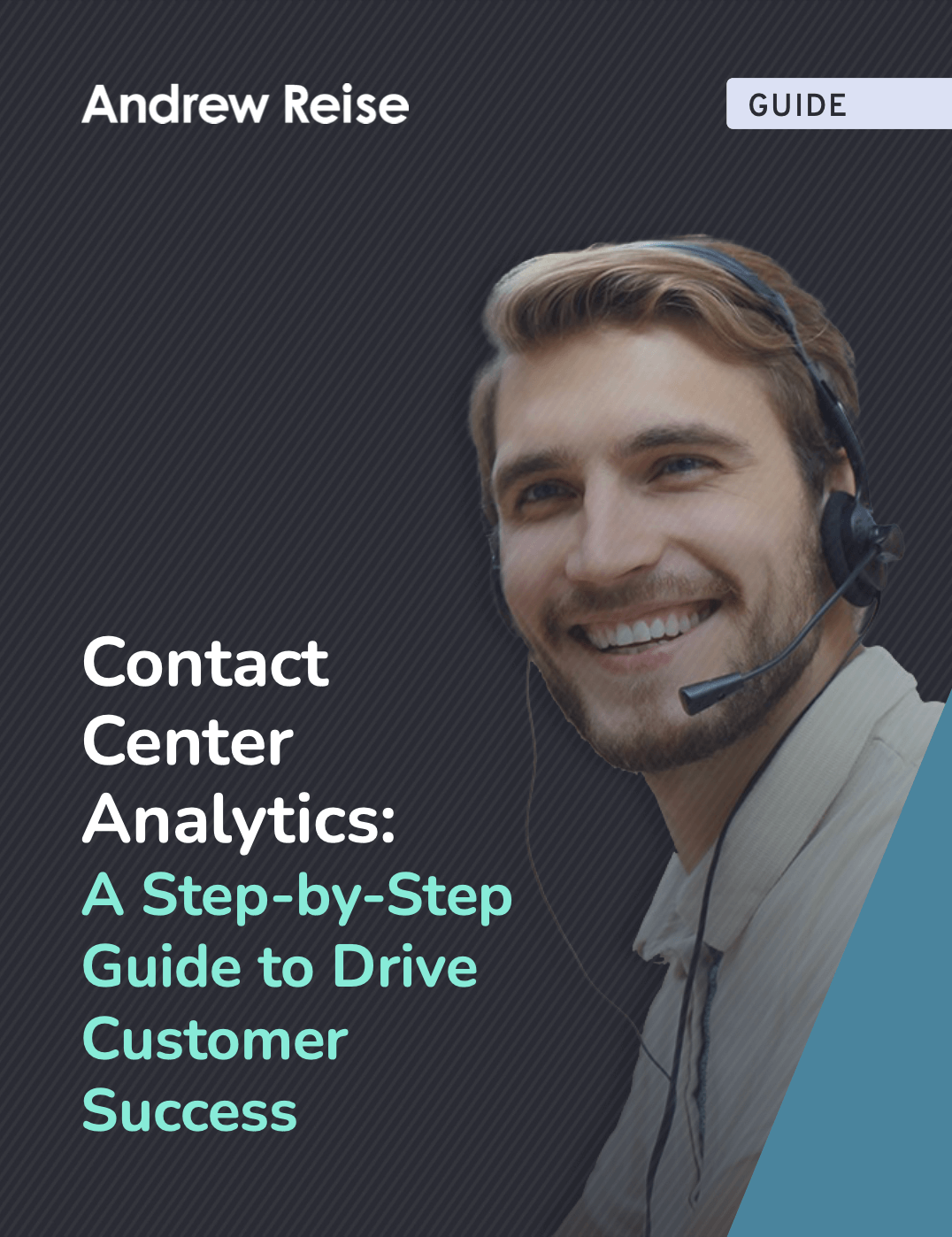Contact Center Analytics: A Step-by-Step Guide to Drive Customer Success
Introduction
The contact center directly shapes the customer’s experience (CX). In fact, 97 percent of customers say customer service interactions influence their decision to be loyal to a brand.
Improve CX in the contact center, and the company can burst open the gates to better experiences, more loyal customers, and faster growth. However, it’s not easy to know how to pinpoint weak points or spot opportunities to improve CX in the contact center.
Enter the business leaders’ secret weapon: contact center analytics.
Contact center analytics unearth CX data and shine light on the most valuable opportunities to improve customer experiences. When these programs are mastered, they peel back the curtain to showcase customer friction points, performance pitfalls, and high-ROI investment opportunities.
Download a PDF version of this guide by filling out the form below


Chapter 1
What Are Contact Center Analytics?
Call center analytics is a process where a company gathers, examines, and makes sense of important customer service information. These insights reveal actionable CX data that businesses can use to elevate customer experiences. Here are a few ways to use call center analytics:
- Improve performance: Analytics can uncover areas where call center employees are being tripped up or losing productivity. For instance, speech analytics may show that agents receiving low positive caller feedback also use phrases that lack confidence. Adding extra, targeted coaching could boost agent performance, improve their experiences, and increase positive customer sentiment.
- Identify costly friction points: Contact center analytics also shine light on moments when customers are running into problems they may not know how to articulate. For instance, data may show customers are frequently needing contact center help with the same online task. With that information in hand, leaders can fix the problem and eliminate these kinds of friction points, and their associated costs, in the customer experience.
- Uncover new revenue opportunities: Analytics in the call center can echo into the far reaches of the company. For instance, interaction analytics can show companies what complementary products customers ask about or what competitor products or services customers are mentioning. With that information, the company can prepare a response in the marketplace.
Companies that want contact center agents to create “next offers” or push bundles can use analytics to increase sales. Contact center analytics can reveal how often agents are making those offers, identify where agents are getting tripped up, and even highlight individual agents who may need reminders or training. - Identify cost savings opportunities: Analytics can spotlight unnecessary tasks and opportunities to save the organization money. For example, analytics can flag product issues early on so companies can get ahead of a surge in returns or calls.
Another big cost saver is when companies use analytics to find trouble areas in a knowledge management system, where agents struggle to find the right answer. If analytics reveal agents are struggling between disjointed systems or clicking more frequently than they should, leaders can step in and improve the operation. Operational analytics—such as schedule efficiency analysis or service-level agreements (SLAs)—can also increase productivity and reveal opportunities to lower costs.
Types of Contact Center Analytics
There are five important types of contact center analytics to consider:
- Speech analytics: Analyzes audible language from call centers. It taps into technology such as natural language processing (NLP) and machine learning to transcribe and find patterns in live interactions or recorded conversations.
- Text analytics: Examines written language from customer reviews, social media posts, emails, surveys, and other written documents. This tool maps out trends, customer sentiments, customer behaviors, and other useful patterns throughout the customer’s experience.
- Desktop analytics: Monitors an employee’s activity, performance, and workflow patterns. These tools follow digital movements, such as clicks, application usage, and keystrokes, so leaders can locate workflows that spark higher productivity—or improve employee experiences.
-
VoC and VoE analytics: Examines the behaviors, preferences, needs, and challenges of customers or employees. Voice of customer (VoC) analytics reveals what customers are experiencing and points out opportunities to improve their satisfaction levels. Voice of employee (VoE) analytics can highlight factors that impact employee experience so leaders can improve work culture, reduce employee turnover, and encourage more positive interactions with customers.
- It’s important to note that VoC and VoE are solicited, whereas other types of analytics on the list aren’t. While other analytics programs feed off of recordings, desktop usage, and other metrics, these tools rely on direct, strategic questions. And the response rate tends to be around 5-15 percent, while other tools analyze 100 percent of interactions. Rather than standing alone, all of these sources work well at filling in the blanks or painting a more complete picture of customers and employees.
- Operational analytics: Unearth performance metrics, cost-saving opportunities, and paths to higher productivity. These tools let leaders monitor and improve their operations through performance-based initiatives.
This type of analytics also opens up a wealth of operational information, such as schedule adherence, SLAs, forecasting accuracy, time to resolution, number of cases opened, and more. With so much information flooding in, it’s easy for leaders to become overwhelmed. The key to using operational metrics effectively is deploying the right ones for the right audience and purposes.

Chapter 2
What Are the Benefits of Contact Center Analytics?
Contact center analytics hand organizations four significant advantages:
1. Boost CX: Analytics can help companies understand and improve CX throughout all of the organization’s interactions.
2. Elevate operational performance: Analytics can also drive more productive and profitable company operations.
3. Reduce employee turnover: Employee-focused analytics, such as VoE, can lead to higher employee satisfaction, more positive interactions with customers, and less employee turnover.
4. Cost savings and revenue generation: Operational analytics magnify opportunities to lower costs, increase efficiency, and grow revenue.
How Contact Center Analytics Improve CX
Here are a few ways contact center analytics can lift CX and increase customer loyalty:
- Identify customer pain points: Analytics highlight customer pain points and their needs.
- Eliminate high-cost complaints: Contact center analytics can illustrate what common problems are hurting CX, so leaders can build a plan to eliminate them.
- Understand customer sentiment: Analytics makes it possible to gauge customer feelings over time, replicate positive experiences, and cut down on negative experiences.
- Identify popular customer channels: Analytics reveals what channels customers are using, so organizations know where to focus time and resources.
How Contact Center Analytics Improve Operations
This is how contact center analytics can improve operational performance:
- Locate performance weak spots: Analytics can reveal moments when agents are not well supported. For instance, analytics may show how well an agent is handling calls, how satisfied customers are with calls, or how long it takes to resolve an issue. With those insights, call center leaders can make strategic changes that uplift performance.
- Replicate positive performance: Analytics also shine light on positive performance. By identifying high-performers and the secrets to their success, leaders can create processes that replicate those moments across the contact center.
- Reduce costs: Analytics can showcase opportunities to cut operational costs or resolve issues that are causing customers to leave.
Identify important touchpoints: Analytics unearth important customer touchpoints so leaders know where to invest time or money for the highest yields.

Chapter 3
How to Launch a Successful Contact Center Analytics Program
Here are the simple steps to launching a successful contact center analytics program:
1. Define Objectives and Scope
Before kicking off an analytics program, contact center leaders should map out clear objectives. That means pinning down specific goals the team wants to accomplish and deciding how they align with the organization’s broader mission.
2. Identify Key Stakeholders
Call center analytics will reveal problems from all corners of the organization. That’s why it’s important to identify the stakeholders who will need to be a part of the analytics program. That might include employees who are directly involved, such as data analysts, data scientists, call center leaders, and IT professionals. It also means designating point people from customer service, operations, training, and other important departments.
3. Establish a Data Strategy
Identify what data sources are available and adopt a data strategy or methodology that the organization agrees on. Make sure the strategy addresses:
- Data collection
- Storage methods and durations
- Integration tactics
- Quality assurance methods
- Governance
This is also a good opportunity to identify any gaps, missing data, and challenges that need to be addressed upfront.
4. Build Contact Center Analytics Teams
Next, assemble an analytics team to execute the company’s data strategy. This may include technical teams of data analysts, data scientists, and data engineers. It should also include call center leaders and insiders who understand how agents work and how the call center runs.
5. Define Metrics and KPIs
Once a team is set up, pick out KPIs and metrics that line up with the business’s objectives. These figures will prove ROI, display progress, and spotlight needs. Always make sure metrics are specific, measurable, achievable, relevant, and time-bound (SMART).
6. Choose Tools and Technologies
Pick out a data analytics tool or tools that can store, process, connect, and visually map out data. Generally, it’s best to use technology that draws in data from as many sources as possible and pools it together. This can help the company solve cross-departmental problems and it makes it easier to set up advanced technology (such as CX automation tools or AI).
7. Develop Data Governance and Privacy Policies
Create data governance and privacy policies that keep data secure, compliant, and uncorrupted. Determine who is responsible for what data role and who will have access to data.
Pro tip: Try to democratize data as much as possible. That means giving key leaders from across departments regular access to analytics reports that may impact their corner of the business.
8. Implement Analytics Processes
Build out workflows that explain how data will be collected, analyzed, modeled, and reported. This is also a chance to create best practices for data hygiene, modeling techniques, and quality assurance.
9. Communicate and Visualize Insights
Create communication strategies that present insights in a highly visual way. Tailor these visual presentations for individual stakeholders and be sure to show how actions will impact the broader organization’s goals.
10. Continuously Learn and Improve
Set up processes, practices, and a company culture that embraces continuous learning. That means constantly analyzing results, looking for ways to improve, testing results, and repeating that process.
Overcoming Common Contact Center Analytics Challenges
Contact center analytics programs aren’t always easy to enact. In many cases, business leaders will run into the same set of challenges. These are the most common challenges organizations run into as they build and work with new contact center analytics programs:
Being Viewed as “Big Brother”
Any time a business starts monitoring employee interactions, it risks losing employee trust. If the workforce feels like they constantly have someone peeking over their shoulder, it can hurt morale and drag down their experience.
To avoid being viewed as “Big Brother,” company leaders can do a few things:
- Celebrate productivity wins early and often. Analytics can showcase agents who consistently perform well or even shine light on instances when they go above and beyond for a customer. Emphasizing these wins helps highlight the positive side of contact center analytics for employees.
- Emphasize the potential for positive customer experience gains and how they will make work less stressful.
- Explain how analytics are meant to improve workflows, identify shortcuts, and make work easier for the employee.
Narrow Data Sources
Call center analytics may focus on one wing of the business, but the data will unveil issues that rarely stay within the walls of the call center. That’s why it’s important to draw in as much data as possible. The more information the organization can pull in, the more dynamic it will be—and the faster the business can make positive strides toward organization-wide goals.
Working in a Vacuum
Too often, different departments will analyze their own data and wall themselves off in their own corner of the business. But working in silos handcuffs teams that need cross-departmental support to solve issues.
The solution?
For one, designate an analytics point person who will work with each department head to seize opportunities and solve all of the organization’s problems. It’s also important to identify reporting or dashboards that leaders across departments can share. For instance, product and web teams need access to app failure and success reports. By sharing this information further across the company, others can understand more about their part of their business, such as call volumes that resulted from recent app failures or website outages. Essentially, if a department can use a report, they should have access to it.
Analytics Methods and Tools
Once contact center data is rolling in, it’s common to feel overwhelmed. That’s why business leaders need to identify a clear set of analytics techniques and tools that put that data to use. Here are a few analytics methods and tools that organizations can use to boost CX:
- Sentiment analysis: This includes surveys, text analysis, speech analysis, and other data that shows how customers feel about a product, feature, or interaction. It’s a valuable tool for leaders who want to see what areas are causing significant reactions—whether it’s frustration, anger, satisfaction, or anything in between.
- Customer journey analysis: Journey analytics help organizations locate pain points and friction across different touchpoints and channels. This information helps organizations improve customer experiences and deliver more value, faster.
- Voice of the customer (VoC) analytics: VoC analytics pulls in customer feedback and uses it to map out their needs, concerns, and expectations. VoC Analytics helps the company understand the customer’s perspective and improve customer experiences.
- Voice of employee (VoE) analytics: VoE analytics examines employee challenges and gives employees a chance to describe CX issues they’re seeing—as well as potential solutions. These tools allow company leaders to see customer interactions more clearly, improve employee satisfaction, and reduce employee turnover.
- Customer segmentation: Customer segmentation involves using analytics to categorize customers based on their behaviors, characteristics, preferences, or other details. This makes it easier to create customer personas and deliver personalized experiences.
- Customer lifetime value (CLV) analysis: CLV analysis will estimate the possible value a customer could create during their full relationship with the organization. This helps organizations quantify how much strategic initiatives and changes could affect the business’ bottom line.
Resources

Chapter 4
How to Secure Buy-In for Contact Center Analytics
No contact center analytics program stands a chance if it’s dragged down by resistance from leaders or employees.
Here’s how to secure buy-in from leaders and stakeholders:
- Bring in experts: The easiest way to secure buy-in is to hire experienced consultants who know how to prove ROI and build support for contact center analytics programs throughout an organization. Outside experts bring experience from multiple industries and understand how to identify strategies that churn out high returns, and they have experience winning over key stakeholders.
- Launch a pilot program: Sometimes it’s easiest to show stakeholders how a program works by jumping into it. That means launching a pilot or trial program, gauging results, and displaying the program’s potential.
- Showcase ROI: Stakeholders care about how improvements in the contact center impact the organization’s bottom line—and its future. That’s why it’s wise to track ROI and weave together stories about how analytics contribute to long-term growth.
Here’s how to secure buy-in from employees:
- Explain incentives: Set up rewards programs for high-performing employees and explain how analytics will spotlight top performers.
- Highlight benefits: Describe how analytics programs will make work easier for the workforce, cut down unnecessary work, and improve employee experiences.
- Identify coaches: Locate “champions” among contact center leaders and employees. These are the people who have already bought into the contact center analytics program. They can help bring challenges to the surface, communicate with peers, and coach coworkers.
Launch an Efficient Contact Center Analytics Program
Andrew Reise Consulting’s team of experts have years of experience launching contact center analytics programs and spearheading CX and Contact Center transformations. Our team listens to each business’s customers, employees, and leaders. From there, we learn about the organization’s needs and work alongside business leaders to help them hit their business goals.
Want to start building a winning contact center analytics program? Contact one of our consultants to see how we can help your company surpass customer expectations.









